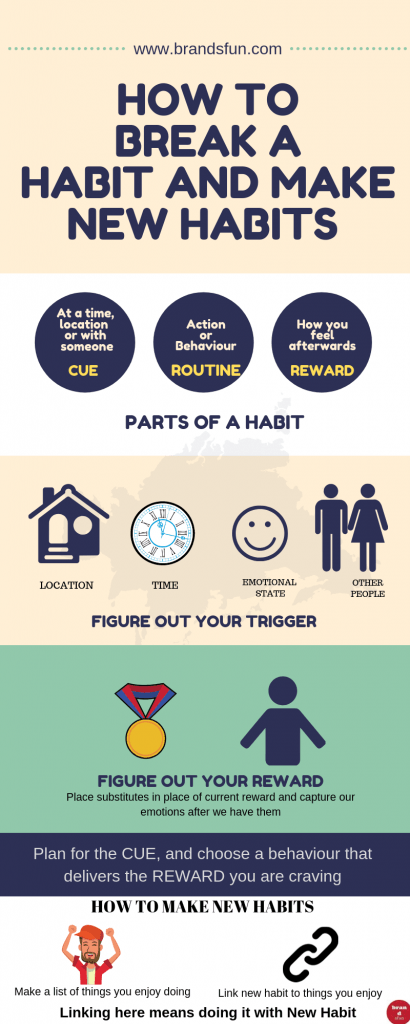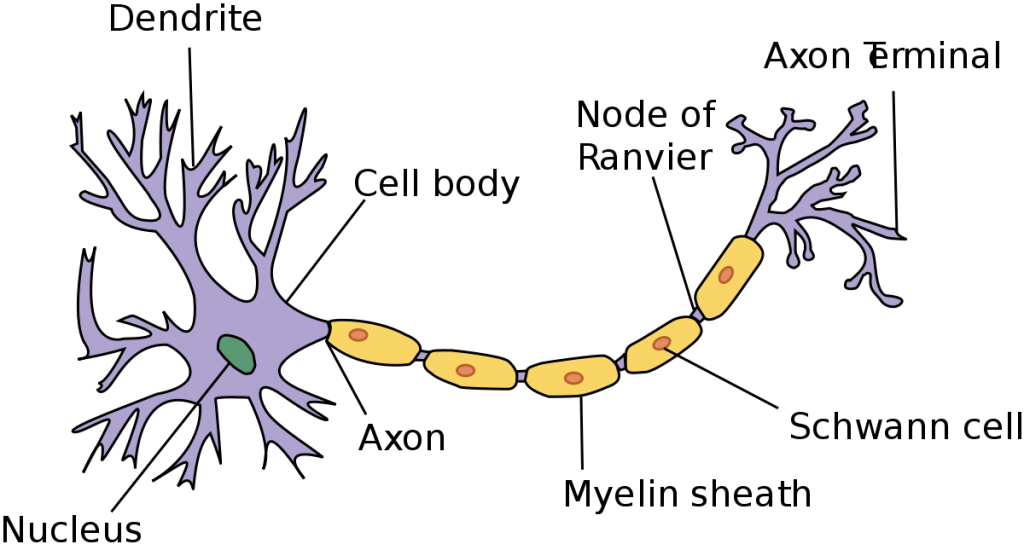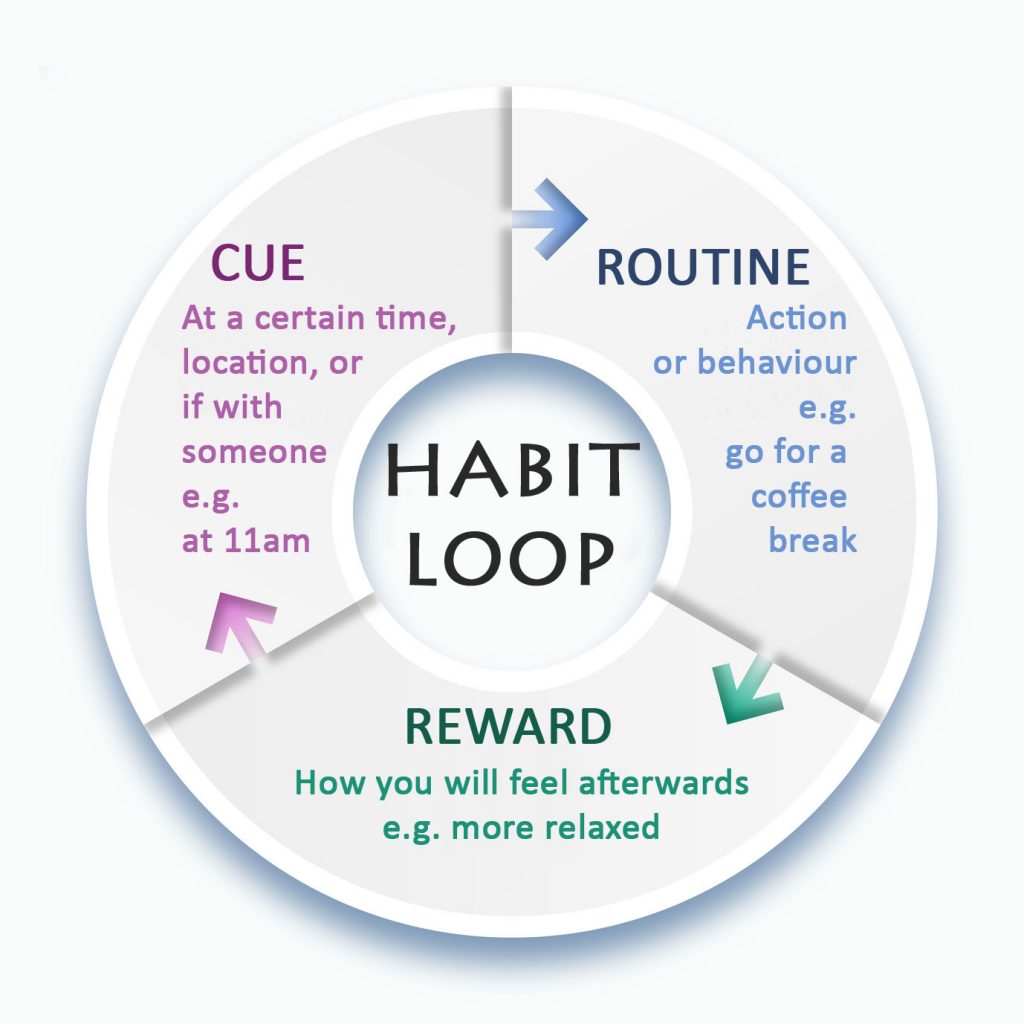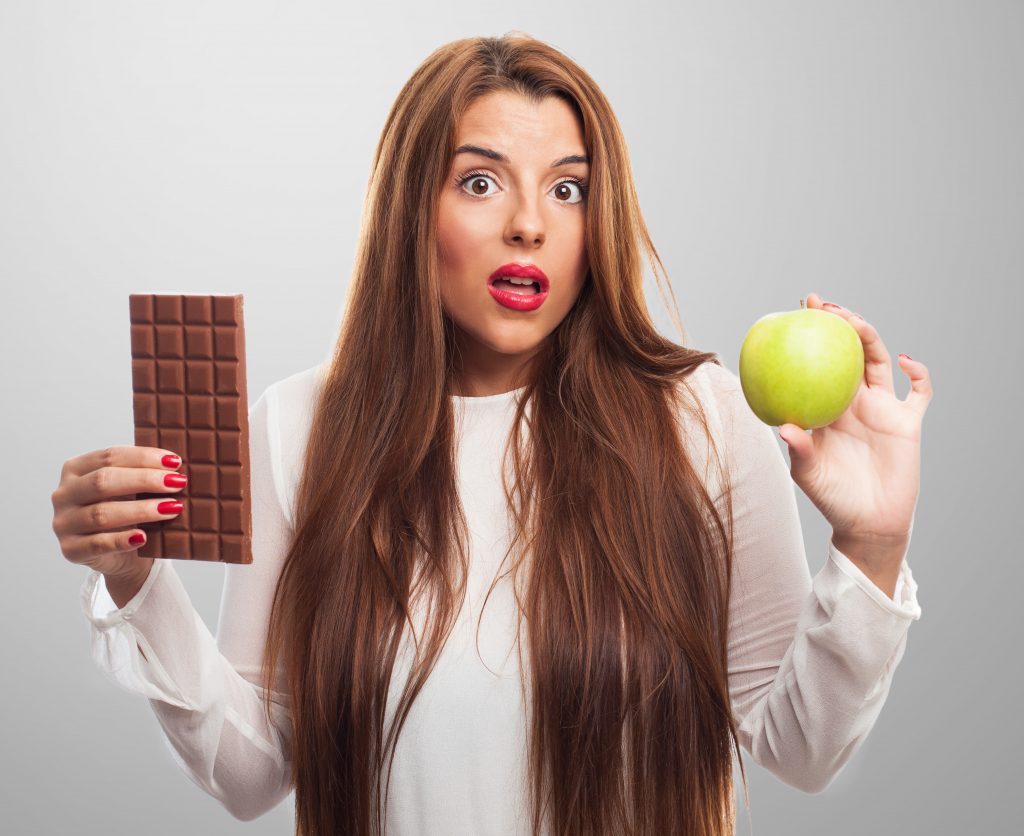
We are stuck in our habits without even realizing it. You might be reading this on your desktop or mobile which is also a habit.
So what I will try to do here is make you understand how habits are formed and how you can alter the structure of same. You can then easily figure out how to break a habit and make new habits
Have you guys noticed that the first time you do something it’s very time-consuming? We have to activate various parts of the brain to perform any new task. The first time we do something new it takes a hell of a lot of time, our brain needs to adjust to the task and learns about it, needs more focus and energy for the task
Next time we do the same task, the brain does a process of myelination. To understand this, we need to understand the working of our brain

The brain is made up of about 86 billion nerve cells called neurons. A neuron has 4 basic parts: the dendrites, the cell body (also called the “soma”), the axon and the axon terminal. Dendrites are extensions from the neuron cell body that takes information from the cell body. Myelin is a fatty substance that surrounds nerve cells to insulate them and increase the rate at which information is passed along the axon
Myelination in anatomy is defined as the process of forming a myelin sheath around a nerve to allow nerve impulses to move more quickly.
According to Research, myelination increases both the speed and strength of the nerve impulse by forcing the electrical charge to jump across the shed to the next open spot on the axon.
Strength and speed were getting better and faster at what we’re doing every single time we do it. So the for a habit to become a habit we need to repeat the same over and over again.
So as we practice when we learn how to drive for the first time
First, the new connections grow after which the more we send signals through this connection, the faster and stronger it becomes.
After some time it becomes natural that we don’t even have to think about it anymore. The action became automated
How to break a habit
As much as 40 percent of everything we do isn’t actual decisions but habits. At some point, we’ve consciously decided to do something a certain way after the same is repeated and it automatically becomes a habit
Eg: Brushing teeth in the morning and at night.
Our brain is constantly on the lookout for ways to save effort. Without our habits, our brain would be overwhelmed by the number of decisions we need to take
So unless we deliberately, consciously go against the habit, the action will take place.
Another thing about habits is that they never really go away. At best they become dormant somewhere and can be reactivated again
It’s like driving. Once it’s in our system it stays there.
The biggest issue with our habits is that our brain is incapable of segregating a good and a bad habit. From a brain perspective, it’s just an energy-efficient action and does not assign moral judgment to it
This leads to us developing bad habits. Habits that are sometimes even damaging for our health or our social relations. And these bad habits, don’t go away. Once they are formed, even when we give up, they can be activated again at any moment.
We have seen smokers get back to cigarettes when under stress.
Habits can be reshaped and redesigned once we understand how they work.
Understanding Habits
A habit is, in essence, an association of three parts:
The cue,
The routine or the action itself,
Reward.

Cue
Cue trigger’s habit. Experiments have shown that almost all habitual cues fit into one of five categories:
Location
Time
Emotional State
Other People
Immediately preceding action
For example, Feeling Sad. Feeling sad itself is a trigger for your next action, which you most probably do on autopilot. Feeling sad is an emotional state, a cue on which you take your next action…..
Action
Carrying forward to the previous example of feeling sad
Do you push the music player button? Do you put on TV? do you say hello to your friend? whatever it is,
Chances are you’re not even thinking about it anymore.
It’s been automated and the trigger is waking up.
Routine can be physical, mental or emotional. Due to the trigger, we start doing a thing, but it can also trigger thoughts: negative or positive emotions
For example, an old song will make us nostalgic. The school will remind us of our first love
Reward
Routine is followed by a reward, which is the signal for our brain to figure whether this particular association is worth remembering for the future.
Rewards can range from drugs or food to emotional payoffs like praise or even self-congratulations. On a chemical level, the reward is the release of dopamine in our brain, which happens every time we enjoy something.
Over time, if repeated enough, these associations – cues, routines, and rewards – become intertwined. Dopamine builds up leads to anticipation and craving.
Every time the cue starts, we feel a strong urge to get the reward and thus we do our routine.
How to Change Our Habit?
Now that we’ve seen identified how a habit works and parts of the same, we can tweak it.
Of the 3 parts of the habit, Action is an obvious and easy one to figure out, the hard part is figuring out trigger and action
The trigger is usually the starting point.
Step 1
How to figure out our trigger
In some cases, it’s simple to figure out the trigger. Seeing an ice cream shop will tempt you to have ice cream. Whereas many times it’s not easy
In such cases write down on a piece of paper, the moment the trigger hits you these 5 things
Location
Time
Emotional State
Other People
Immediately preceding action
Repeat it for a few times when you have the trigger. Analyze the data to figure out which one of these forms your trigger. Which of these 5 things is the same each time? This becomes your actual trigger
Once you figure out the trigger, it’s time to get to figure out rewards
Step 2
How to figure out Reward
The reward can be figured out by placing substitutes in place of current reward and capturing our emotions after we have them
For example: If the habit we want to change is the habit of having an ice cream after dinner
Try a substitute for ice cream for 3-4 days
Have chocolate on the first day
And then write down on a piece of paper how you felt after having it
After 15 minutes, check if you still have cravings for ice cream and write down the same again
Repeat the same with nuts. juice etc for 3-4 days
It’s important to write it down for you to analyze it after 15 minutes
At 4th day check if you still crave for ice cream or you can substitute with something else
If it can be substituted it means, it’s not the ice cream but maybe something else like socializing or going out after dinner that is the reward
So just start walking the next day after dinner could be the answer
So we could just change the action and change habit
Step 3
Once you figured out cue triggering your habit, action, and reward driving your behavior and routine. it’s time to fix the habit you always wanted to fix. You can change to a better routine by planning for the cue, and choosing a behavior that delivers the reward you are craving. What you need is a plan
If smoking at 4 Pm is a habit you want to change
Assuming that you understand the cue to be 4 pm and the reward to be socializing
Plans can be walking up to a friend’s desk for chitchat or catching up at teashop at 4 pm
Make a clear plan and try abiding by the same. Some days you may miss it, but eventually, you will be successful and overcome the habit.
How to make new habits?
Now I will tell you a simple strategy to remove your old unwanted habits and add some great habits to your daily schedule.
Habits depend a lot on your motivation. There are two types of motivation – Intrinsic and extrinsic
Intrinsic motivation means doing something because it’s personally rewarding to you. Extrinsic motivation is doing something because you want to earn a reward or avoid punishment
When most of us get stuck is we start associating new habits with extrinsic motivations.
For Eg:– Kevin wants to lose weight. he goes to the gym, which he hates.
And every time he loses one pound he rewards himself by going shopping.
The external motivator. If he doesn’t lose weight there is no reward and dropping out is lurking around the corner.
So instead of linking to results from losing weight, Kevin should link the activity, exercising, to something he loves… like listening to favorite music while exercising
When activity itself becomes rewarding, it becomes more enjoyable and sustainable
So what are the action points
1) Make a list of the things you enjoy doing which gives you energy.
2) Link one or several of them to the new habit you want to develop
Linking here means you need to do them at the same time as the new habit and it’s that easy.
Our brain will now start associating the new habit with the pleasure of the activities we do like. When we do something we like, we get what is called the dopamine rush
Once we get this dopamine rush going, it becomes a building block for the new habit to be formed
Every time you start doing this, your myelin sheath becomes stronger and it slowly becomes a habit
If you want to create a new habit you need to start thinking in terms of “cue”, “action” and “reward”. Over time as we act again and again, following the trigger and followed by the reward, our brain starts to create a new connection between those three, effectively rewiring our brain.
Things have to be convenient and easy.
Your cue has to become easily associated with your actions.
If you want to go and run every Saturday morning, have the running shoes readily around in plain sight. Don’t hide them in the back of your closet.
If you want to start practicing yoga, keep your yoga mat close by and hang a poster of someone doing yoga somewhere in plain sight.
Whatever new habits you want to instil, make sure to have a visual cue around, somewhere you’ll see it clearly to remind you of the action to perform.
The key to a successful habit starts with a clear trigger.
Finally changing an existing habit or developing new ones isn’t easy. This structure will help you to understand habits and to take action. It will take a lot of practice and will power to change the habit you always wanted. All the best for that
